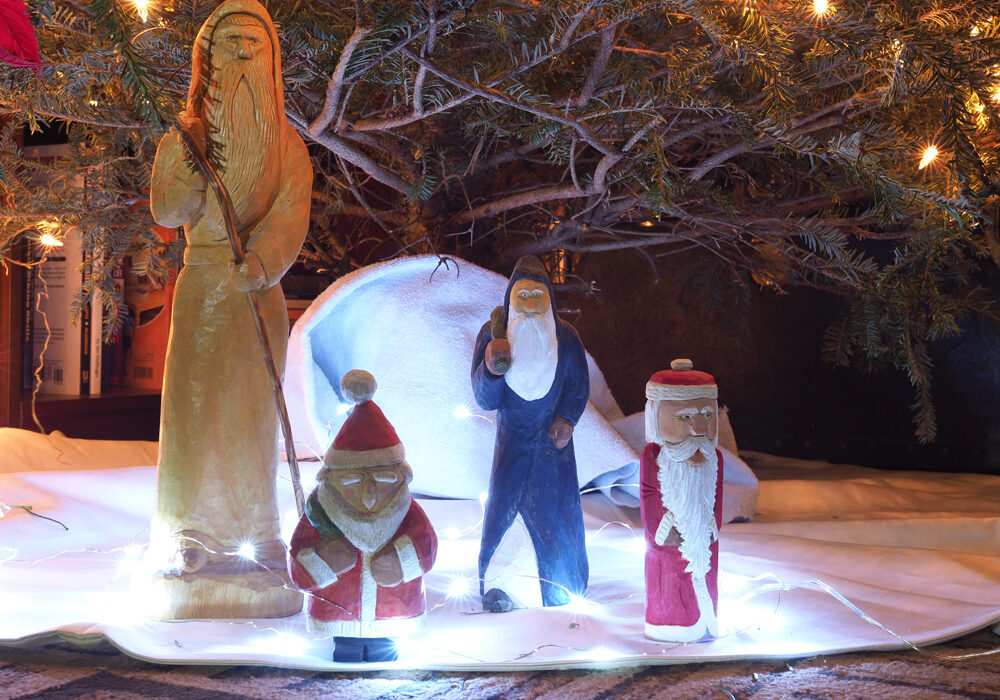
The mainstream version of the jolly man in the red and white suit took shape with the publication of Clement Clarke Moore’s poem ‘An Account of a Visit from St. Nicholaus’ and the later addition of Thomas Nast’s illustrations. Santa’s legend might have originated with Nicholas, a monk who lived in Turkey in the 1st century. Other descriptions include England’s more woodsman-like Father Christmas. Staff photo by Daniel Clifton
I never really bought into the “Santa Claus is Comin’ to Town” storyline as far as how Santa came to be Santa. Though Mickey Rooney did a good job as Kris Kringle, the whole idea of there being a Burgermeister Meisterburger who made children’s live’s miserable just didn’t seem reasonable to me, even as a kid.
So, if this 1970’s stop-motion movie isn’t the real story, what is?
And does the real Santa look like the big-bellied, white-bearded man in red we’ve come to know and love?
Let’s take a trip across the ocean and most of Western Europe and head back a couple thousand years to Myra in Anatolia, or Asia Minor, in what is now Turkey.
During the early first century, a man named Nicholas had dedicated his life to God, serving the sick, poor, and hungry across the countryside.
Nicholas, in some historic reports, came from affluence, unlike most of the people of Asia Minor. But, in serving the Lord, he gave away his wealth to help others, often doing it in a secretive manner so the recipients did not know from where the gifts came. One of the most retold acts of his goodness is when Nicholas provided a destitute widower with dowries for his daughters so they wouldn’t have to face a life of abject poverty.
Another tale of his love and faith in God involves three students who were traveling through the country on their way to Athens when an innkeeper robbed and murdered them. Nicholas was using the same route on his journey and happened to stop at the inn.
During the night, Nicholas dreamt of the murders and went to confront the innkeeper. Then, Nicholas prayed to God, who brought the three students back to life.
There are a number of stories — some true, some legend — about Nicholas. One thing most scholars agree on is that Nicholas was a very pious man and devoted to God.
The people of his time also saw Nicholas as a Godly man. After his death and sainthood, many continued to talk about his service and started honoring him on Dec. 6, which became known as St. Nicholas Day (his feast day). As a tradition, people would give gifts to others in honor of the saint.
During the Reformation, saints fell out of favor as people shunned Roman Catholic practices. But many, especially the Dutch, continued to celebrate St. Nicholas Day and his life, calling him Sint Nikolass in their own language.
It wasn’t just the Dutch. Others seemed to like the idea of a person who gave up wealth to serve others. In England, the legend of Father Christmas, or Old Man Christmas, a man who gave presents across the countryside, took hold. In France, there was Papa Noel.
The Swiss and Germans had Chirstkind, or Kris Kringle, who brought presents to good little boys and girls.
And, in Russia, there’s the legend of Babushka, who got so caught up with her cleaning that she missed the chance to travel with the Three Wisemen on their journey to Bethlehem. Realizing what happened, Babushka grabbed a bag of toys — presents for the newborn king — and took off after the men, through she would never catch them.
By the time she arrived in Bethlehem, Mary and Joseph had fled with the baby Jesus to Egypt.
Some say Babushka’s still out there seeking to find the child, while others say she delivers the toys each year to children near her home instead.
While St. Nicholas bears some resemblance, he’s really nothing like today’s Santa Claus. The Dutch-American author Washington Irving helped make the connection between the two.
Many Dutch had settled in the young United States in New York, originally New Amsterdam. In the late 1700s, the Dutch celebrated Sint Nikolass’ Day, which was often shortened to Sinter Klass.
See where this is going?
In 1809, Irving, in his satirical book “A Knickerbocker’s History of New York,” wrote that St. Nicholas flew above the treetops on his annual trip to give children presents. He even described him smoking a long pipe.
Several historians cite this as the first introduction of the man who would become Santa Claus.
The legend got a boost from an Episcopal priest named Clement Clarke Moore when he wrote a simple poem for his three daughters called “An Account of a Visit from St. Nicholaus,” which we know as “Twas the Night Before Christmas.” The interesting thing is the character in Moore’s poem is a bit like Irving’s satirical St. Nicholas. Apparently, the two men were friends.
However, it was cartoonist Thomas Nast’s illustrations that were added in 1881 to Moore’s words that solidified our picture of today’s Santa.
The illustrations show a rotund, jolly man.
The beauty of all this is that you can envision Santa Claus, or St. Nicholas, however you want, even if he’s the version from a 1970’s children’s film.
So, there’s the story of Santa Claus. (Just don’t ask about Krampus.)
daniel@thepicayune.com









